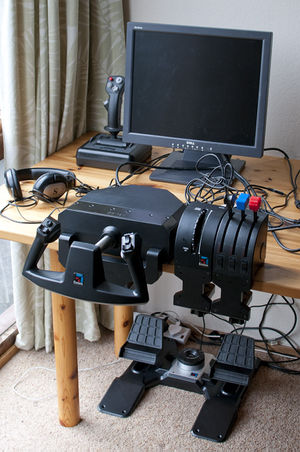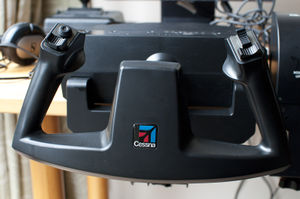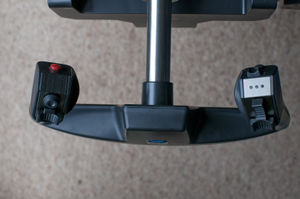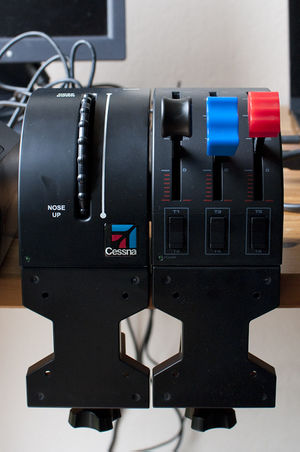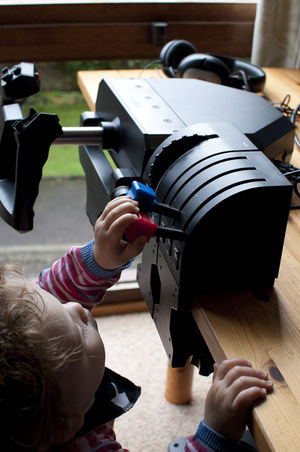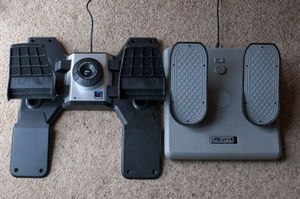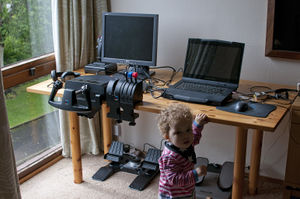Hardware Review: Saitek Pro Flight Cessna controls
The Saitek Pro Flight Cessna series are a set of official Cessna licensed controllers for flight simulators. They are intended to closely represent the controls on Cessna 172 - the default aircraft in FlightGear. The components come nicely packaged in Cessna-branded boxes, and have rather nice Cessna logos on them.
At time of writing, the product line consists of the following.
- Pro Flight Cessna Yoke (which includes a 3-level quadrant module)
- Pro Flight Cessna Trim Wheel
- Pro Flight Cessna Rudder Pedals
As of version 2.8.0, these controls are fully supported out-of-the-box in FlightGear. Saitek also produce non-Cessna branded Pro Flight yoke, quadrant and rudder pedals. Though I haven't used them, based on photos I expect they are very similar in quality and function. In particular, the rudder pedals appear to be the same chassis, but with different pedals, and the throttle quadrant is identical to that provided as part of the Pro Flight Yoke System and Throttle Quadrant products.
The background to this review is worth explaining. A new FG user posted a request for help configuring his new Saitek Cessna controls on the FG forums. They didn't work out of the box as no configuration files existed, and he didn't have enough experience to write the config himself. I offered to help, intending to iteratively write configuration files and have him test them. As this was going to be a very slow process, I contacted Saitek and explained the issue. They very kindly sent me a full set of controls so I could write FG configurations files and this review.
Yoke
The centre-piece of the controllers is a Cessna branded yoke. Saitek claim it's a 1:1 reproduction of a Cessna yoke, and it certainly looks and feels right to me. The 172 has been produced for more than 50 years, with a variety of different yoke styles, and I have only a couple of hours experience in the real thing, so I may not be the best judge. Obviously there are concessions to it being a simulator yoke - for one thing there are many more buttons than on the real thing, which typically just has a PTT switch. The shaft of the yoke is metal, and there are metal detailing on the top of the yoke and the body, but the yoke itself is made of some solid feeling plastic.
All the buttons are mounted on the yoke itself, and there are a lot. Below is a quick run-down of the buttons, and their standard assignments in FG in v2.8.0. Of course, these can be change by editing the XML configuration file.
Left hand arm:
- Red button: Push To Talk (FGCom)
- Coolie Hat : View direction (Note that the granularity of the movement is controlled by the sliding switch on the right hand side)
- Left hand 4-way switch: Zoom In/Out (forwards/backwards), Change View (left/right)
Right hand arm:
- Black Button: Reset view
- 3-position sliding switch: Change view direction granularity.
- Vertical switch: Elevator Trim
- Horizontal switch: Rudder Trim
At the back of the yoke there is a set of USB ports, plus a PS/2 for the quadrant, and a 6V power input in case you need additional power for USB peripherals. I found this very useful, as I simply plugged the quandrant, trim wheel and pedals into this, and then had a single USB connection from the yoke to my computer. Of course, this doesn't solve the problem of having 4 cables connecting all the components, so I have a bit of a rats nest of cabling on my desk. Maybe in the future we'll have wireless control peripherals.
Like all simulator yokes this is a large piece of kit, requiring much more space than a joystick, and needs to be secured to the table using a supplied bracket. Its 28cm wide, 26cm deep, 10cm high. It comes with a bracket to secure it to a table surface, and it's worth noting that the maximum table thickness the bracket can handle is 5cm, and it extends under the table by 12cm. I had to change the table I use for my computer to provide enough space and appropriate thickness for the yoke.
So, what's it like to fly? Very nice indeed.
The yoke movement is nice and smooth, with the deflection force required increasing quite linearly with deflection distance (apart from a small zone in the center), so it takes some effort to hold full up elevator with the yoke pulled right back. The yoke self-centers when released, and I suspect uses springs for centering. There's no force-feedback option with FG, but this does provide some feedback of control deflection, particularly when you're flying out of trim. In comparison the deflection force on my joystick is largely constant, making it more difficult to "feel" the amount of control deflection just by the force on my hand. Left/right travel is 180 degrees, and forward/back travel 8cm.
For flying a GA aircraft like a 172, the Beaver or indeed a traditional airliner or business jet, it simply feels more natural than using a joystick. You become much more aware when your aircraft is out of trim, and trim with every power or attitude change rather than simply holding a bit of back or forward pressure. More realistic, and more fun.
The buttons are quite sensitive, and placed so that ones left thumb lies across both the 4-way switch and the coolie hat. The intention is that one can manipulate both controls at once so it's easy to zoom in while adjusting the view direction at the same time. However, due to the sensitivity of the controls it is a bit too easy to change view when trying to adjust your view direction. Some care is required.
Quadrant
The quadrant is sold with the yoke, and is the standard quadrant that Saitek provide with their Pro Flight Yoke System. It has three levers for throttle, propeller and mixture, with differently shaped black, blue and red knobs. As well as having the normal axis of travel, all three levers can be pushed past the 0% mark for reverse thrust, propeller "beta", or mixture cut-off. At present the FG configuration files do not take advantage of this, but Saitek's approach of using a "button" signal when in the reverse/beta/cut-off position would make this straightforward without compromising the use of the quadrant for aircraft that don't support such operations. Nicely done, and I expect to use this in the future when I work out what the common beta controls are on FG aircraft!
Underneath the quadrant are 6 buttons, arranged into three vertical pairs. These are well placed for flaps, gear and spoilers, and indeed that is how they are mapped in FG by default.
The quadrant is designed to sit nicely next to the trim wheel, or another quadrant, with a detent in the side to match them up, and identical profile. The knobs on the levers can be swapped around so you could purchase another quadrant and set it up with separate engine throttle, prop and mixture controls for twin engine control in a DC-3 or Seneca.
The quadrant can be mounted on the supplied bracket so that it either sits on top of the table, or roughly level with the table edge. This latter position places it more naturally relative to the yoke, but obviously means that it sticks out more. Personally I have it mounted high to keep it out of the reach of my children!
The quadrant connects to the yoke via a PS/2 connector rather than being a separate USB device. I suspect this was done to allow different assignments of the quadrant buttons when the mode selector on the yoke is changed with the Saitek drivers. Unfortunately, a side-effect of this is that the quadrant cannot be used without the yoke. I had hoped to be able to use it with my joystick for flying the P-51d Mustang, which requires juggling the throttle and mixture during startup, but that would require me to buy another throttle quadrant.
Flying with the quadrant is much better than using the throttle control on my joystick. The movement has a good level of damping, and it's very nice to have a straightforward indication of the current setting by feel or visually, as there are percentage markings on the quadrant itself. I now stop the engine of the 172 properly by pulling the mixture out, rather than switching off the mags.
The only fly in the ointment is that 0 throttle/prop/mixture is reported until about 15% on the lever, and full throttle/prop/mixture is signaled from the 85% mark. This is a limitation on the signal being sent to FG, and is common on other joystick throttle controls as well. I suspect is to ensure that the throttle can still be set to 0 and 100% even if manufacturing tolerances are wide. This reduces the actual control travel of the levers, where you input will have an actual effect from about 85 degrees to 60 degrees. This is still a significantly better level of control than a simple joystick throttle, and the input is very noise-free, but is a slight disappointment given the quality of the yoke.
The real 172 has push/pull vernier controls rather than a full quadrant. Saitek do sell a set of these as their "TPM" (Throttle, Propeller, Mixture) product. I do not know whether this would work with FG, but I suspect it would with an appropriate configuration file. If anyone would like me to write one, please send the hardware to the usual address...
Trim Wheel
While the yoke, throttle and pedals are similar to other products in the Saitek range, the trim wheel is unique. It consists of a single wheel set up to change elevator trim. Readers who have spent any time flying real aircraft will know the importance of trim, and while most joystick bindings include a control for this, the experience is quite different. For starters, this is a real control axis, so the setting is not reset between flights. The first time I plugged it in and tried to take off with the FG 172, I stalled on take-off as I hadn't checked the trim position, having assumed it was set to the default. The second difference is that with 9 full rotations from full nose-down trim to full nose-up trim, there's a lot of sensitivity available if you require it, or you can just roll in a "handful" of trim as you change from initial climb-out to cruise.
While a really simple control, I find this really adds to the realism of the sim. Rather than simply blipping the trim control on my joystick, I have to reach and turn the trim wheel itself on every attitude change. The wheel has the characteristic knobs of the Cessna controls, though I'm not sure if it's a 1:1 replica - I suspect it's slightly smaller to stay a reasonable size for the desktop.
In testing on Linux and MacOS, I found intermittent problems when connecting the trim wheel though the yoke USB hub, which cause a crash on MacOS, and the trim wheel not to be loaded on Linux. Both these problems can be worked around by plugging the trim wheel directly into the computer. I suspect that this is some interaction between the hub and trim wheel at a low hardware interface level is to blame rather than a problem with FG itself, so it is unlikely that this will be fixed for the 2.8.0 release. If this problem is resolved, I will update this review..
Given my comments regarding the yoke above, I would strongly recommend that anyone buying the yoke also get a trim control.
Rudder Pedals
The rudder pedals are big, widely spaced, and with a large knob in the middle to adjust the force required to move them from neutral. The pedals themselves are intended to mimic those of a 172, and have the characteristic "step" part way up the pedal. As with other rudder pedals, as well as providing rudder control by sliding forwards/backwards, each pedal has a toe brake, allowing differential braking.
I own a set of CH Products Pro Pedals, which I've had for many years, and they provide an interesting comparison. The major difference between the designs is the size and weight of the pedals. The CH ones are smaller and lighter, and requiring less force to move from neutral, even when the Saiteks are on minimum tension. The room I do my virtual flying in is carpeted, and a side-effect of the increased force is that the Saitek pedals need to be braced against the wall to avoid the chassis slipping. The chassis has holes designed to take screws, so one can screw them straight into the floor. They also come with velcro that can be attached to the base to provide grip on the carpet. I haven't suggested either of these options to my wife, but I may attach them to a piece of board in the future.
Ergonomically, they are also different. The CH pedals are significantly narrower, with less space between your feet. This is a bit more realistic for the 172, as there's not a huge amount of space under the instrument panel. Where the Saitek pedals are noticeably better is in the angle your feet have to travel for the toe brakes. The CH pedals are flat and hold your entire foot, and the rotational travel for the toe brakes is quite large. This means you must sit significantly higher and closer to the pedals to be able to apply full brakes. When flying a fighter or an ultralight you feel that you are sitting up a bit too much when using the CH pedals.
I've found that I've been using the Saitek pedals in preference to the CH. My simulator set-up is semi-permanent, and I don't move my kit around. If I had to put it away in a cupboard, the CH pedals would be a better choice, being smaller, lighter and a bit neater.
Summary
The full set of Cessna controls make for a very compelling simulation, and work well together providing a coherent whole. Despite being one of the maintainers of the FlightGear 172, I'd not done much virtual flying in it recently, with the exception of using it to take part in the MP ATC events at the "EDDF Triangle" on a Sunday evening. Having these controls encouraged me to fly the 172 more. I thoroughly enjoyed doing circuits at Reid Hillview (KRHV) and cross-country flights around the San Francisco Bay area. There's something just "right" about flying the 172 with a yoke, and using the trim wheel as you pull back the power to descend. When I get bored with the 172, there are a whole raft of GA and commercial aircraft for which the yoke is the correct control input.
A yoke setup like this obviously isn't for those flying fast jets or WWII fighters, or even the Piper Cub. I tried flying the P51d-jsbsim using the yoke, which is well known for requiring a delicate, quick, touch on take-off. I struggled far more than normal as the yoke is simply slower to control than a stick. For that reason, I'll be keeping my joystick handy for those aircraft that need it.
The kit also takes up a lot of space, and really has to be set up permanently. The yoke is sufficiently large that you can't simply reach around it to type, as you might with a joystick. Similarly, the quadrant and trim wheel will get in the way of trying to use your computer for other tasks, particularly if you have them set up to the right and are right handed. To set up the system properly at home I had to replace my computer table with a larger one that I had in the garage, and set up a separate monitor specifically for FG. I'm quite happy with the results, though negotiation of the permanence of this setup with my wife continues. I may yet have to go back to a joystick and pedals. For many people the space requirements will be a deal-breaker, and a high end joystick is much more spouse-friendly.
There's no getting away from the fact that this stuff is expensive. Total price for the yoke, pedals and trim wheel is around $450. The Cessna yoke ($200) carries a premium over the Saitek Pro Flight Yoke, and the pedals are similar in price to the Pro Flight Combat Rudder Pedals ($200). If you are using a $50 joystick quite happily, this will seem excessive. However, a better comparison is with the equivalent CH products yoke, or high-end joysticks which are comparable in price and are designed to last a long time. A case in point: My first two joysticks cost around $50 each and only lasted a couple of years before there was too much play in the axes to allow accurate flying. I then bought a CH Products Fighterstick for around $150, which is still just as accurate 5 years later. The yoke does come with a quadrant, and discounting that from the price makes it comparable with my joystick. On that basis, the cost is more reasonable.
The pedals are a bit trickier to assess in value for money terms. I think they are definitely better than the CH Products equivalent, but the price differential is difficult to justify. As with the yoke, either set of pedals will last a lifetime. It comes down to whether you want to spend $120 or $200 on a one-off purchase.
The trim wheel is unique, and while it costs the same as a moderately priced joystick ($50), it does offer a step up in simulation, and IMO is worth it for those flying GA aircraft and who have the space. You can justify it with the money you save flying FG rather than a commercial sim!
